Discover the art of crafting unique fragrances using essential oils, exploring natural ingredients and creative blending techniques to create personalized designer perfumes with professional appeal and elegance.
What Are Essential Oils and Their Role in Perfumery?
Essential oils are concentrated plant extracts, capturing the unique scents and properties of flowers, herbs, and other botanicals. They serve as the foundation of perfumery, offering natural, complex fragrances. Unlike synthetic ingredients, essential oils provide authenticity and depth, making them indispensable in designer perfume recipes. Their potency requires only small amounts to create lasting scents. Perfumers classify essential oils into fragrance notes—top, middle, and base—each contributing to a perfume’s character. These oils also double as therapeutic agents, adding an aromatic and wellness dimension to fragrances. Their versatility allows for endless blending possibilities, making them a cornerstone of perfumery artistry.
Importance of Natural Ingredients in Perfume Making
Natural ingredients, such as essential oils and plant extracts, are vital in perfumery for their authenticity and depth. They offer unique, complex fragrances that synthetic alternatives cannot replicate. Using natural components ensures a cleaner, more sustainable product, appealing to those with sensitivities or preferences for eco-friendly options. These ingredients also provide therapeutic benefits, enhancing the overall aromatic experience. By focusing on natural elements, perfumes become not only fragrant but also align with the growing demand for organic and environmentally conscious beauty products, making them a cornerstone of modern perfumery practices.
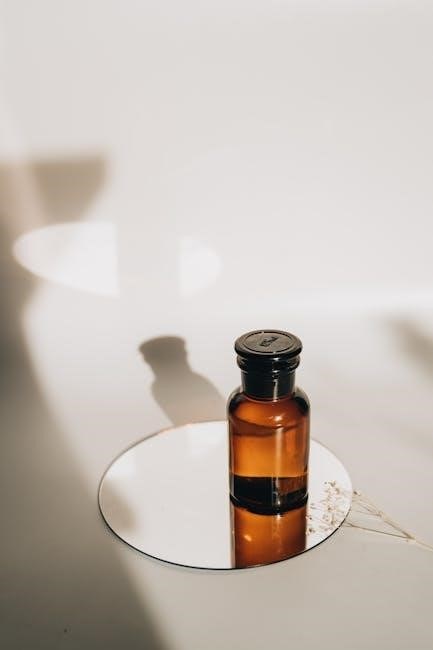
Understanding the Basics of Perfume Making
Perfume making involves blending essential oils, understanding fragrance notes, and ensuring proper dilution ratios. It requires precision to balance scents and achieve lasting, harmonious fragrances effectively.
The Concept of Fragrance Notes (Top, Middle, Base)
Fragrance notes are the layers of scents in a perfume, divided into top, middle, and base notes. Top notes are the initial, fleeting scents that evaporate quickly, often citrus or fresh. Middle notes emerge after, providing depth with floral or spicy undertones. Base notes are rich, long-lasting, and deepen the fragrance, like woody or musky scents. These layers blend harmoniously, creating a balanced and complex aroma that evolves over time, essential for crafting sophisticated designer perfumes with lasting appeal.
Essential Oil Blends: How to Combine Oils for Unique Scents
Creating unique fragrances involves blending essential oils in harmonious ways. Start with a base note oil, like sandalwood or cedarwood, for depth. Add middle notes, such as lavender or geranium, to balance and soften the scent. Finally, incorporate top notes, like lemon or bergamot, for a fresh, vibrant finish. Experiment with ratios, test the blend on skin, and adjust as needed. Small batches allow for precision and customization, ensuring each fragrance is distinctive and tailored to personal preferences or designer-inspired recipes.
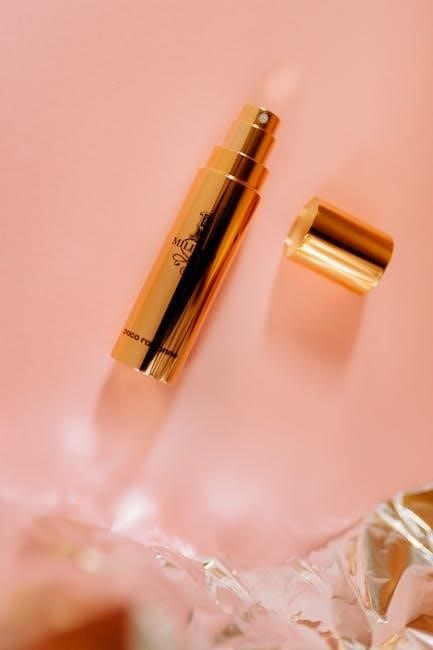
Popular Essential Oil Blends for Designer Perfumes
Explore trendy blends like floral, citrus, and woody scents. Combine lavender, jasmine, and rose for elegance, or lemon and bergamot for freshness. Cedarwood and sandalwood create earthy charm.
Floral Blends: Combining Lavender, Jasmine, and Rose
Lavender adds a soft, calming note, while jasmine provides a sweet, exotic flair. Rose contributes a timeless, romantic aroma. Blending these creates a delicate, balanced floral fragrance, perfect for everyday wear. Start with 3 drops of lavender, 2 drops of jasmine, and 1 drop of rose in a 10ml bottle for a harmonious scent. Adjust ratios to personal preference, ensuring the blend feels smooth and elegant, ideal for those seeking a sophisticated yet subtle perfume experience with natural charm and essence.
Citrus Blends: Creating Refreshing Scents with Lemon and Bergamot
Citrus essential oils like lemon and bergamot offer bright, uplifting fragrances perfect for refreshing perfumes. Lemon provides a zesty, energizing note, while bergamot adds a sweet, citrusy aroma. Combine 3 drops of lemon and 2 drops of bergamot in a 10ml bottle for a vibrant, invigorating scent. This blend is ideal for daytime use, evoking feelings of clarity and joy. Adjust the ratio to enhance either the tangy or sweet aspects, ensuring a balanced fragrance that captivates the senses with its fresh, citrus appeal.
Woody Blends: Using Cedarwood and Sandalwood for Earthy Aromas
Woody essential oils like cedarwood and sandalwood create rich, earthy fragrances ideal for grounding and warm perfumes. Cedarwood adds a robust, woody note, while sandalwood provides smooth, creamy undertones. Mix 4 drops of cedarwood with 3 drops of sandalwood in a 10ml bottle for a deep, earthy aroma. This blend is perfect for evening or winter use, offering a sense of stability and sophistication. Adjust the ratio to enhance either the bold or smooth aspects, crafting a fragrance that embodies natural elegance and warmth with its woody charm.
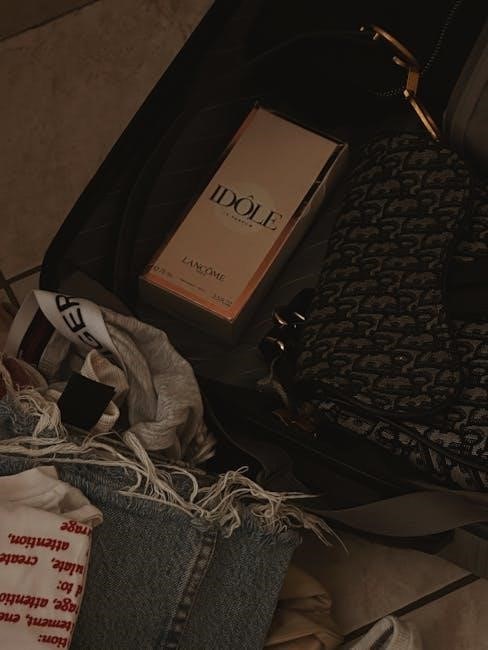
Safety Precautions and Tips for Making Perfumes
Essential oils can be potent, so always dilute them appropriately and perform patch tests to avoid skin irritation. Use high-quality, pure oils and follow proper dilution ratios to ensure safe and effective perfume making, creating fragrances that are enjoyable and gentle on the skin while maintaining their aromatic beauty and longevity naturally.
Understanding Ricing and How to Prevent It
Ricing occurs when ingredients in fragrance oils bind with harder oil components, forming rice-shaped particles. To prevent this, ensure all ingredients are fully incorporated and heated evenly during mixing. Using a consistent ratio of wax to carrier oils, like beeswax and jojoba, helps maintain a smooth texture. Stir thoroughly and avoid overheating, as this can cause separation. Proper blending techniques and ingredient selection are key to achieving a uniform, professional-quality perfume blend that remains stable and visually appealing over time.

Proper Dilution Ratios for Essential Oils in Perfume Recipes
Essential oils are potent, so proper dilution is crucial for safety and scent balance. Typically, a 1-3% essential oil concentration in perfumes is recommended, meaning 1-3 drops per teaspoon of carrier oil. For a 10ml perfume, use 10-30 drops of essential oils, depending on desired strength. Always dilute in jojoba or sweet almond oil to prevent skin irritation. Accurate measurement ensures a harmonious blend that’s both effective and safe, enhancing the fragrance while maintaining user comfort and longevity of the scent.
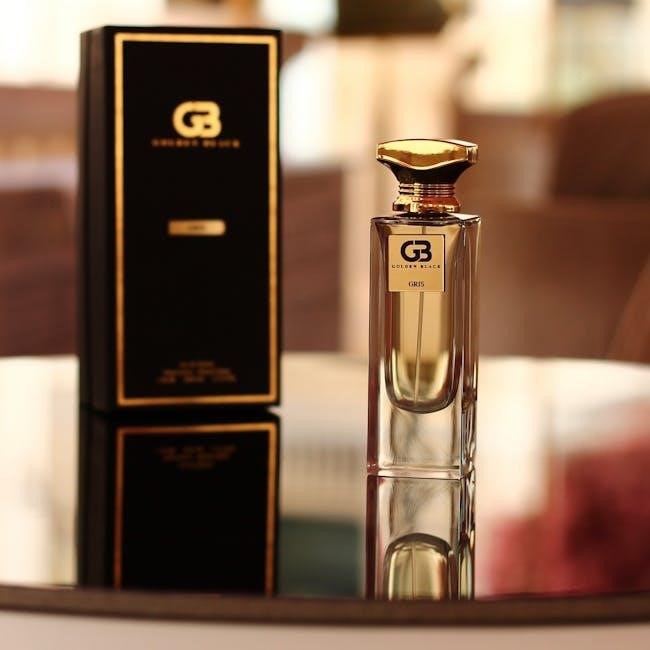
Step-by-Step Guide to Creating Designer Perfumes
Blend essential oils, mix with carrier oils, and test the fragrance. Allow the blend to age for complexity and balance before bottling your unique designer perfume.
Materials and Tools Needed for Perfume Making
To create designer perfumes, you’ll need essential oils, carrier oils (like jojoba or sweet almond oil), and optional ingredients like beeswax or vodka for preservation. Use glass bottles, pipettes, and droppers for precise measurements. A small scale is helpful for accurate ratios, and labels are essential for tracking blends. Store materials in a cool, dark place to preserve oil quality. These tools ensure a professional and organized approach to crafting unique fragrances at home.
A Simple Recipe for a 10 ML Perfume Blend
Combine 10-15% essential oils with 85-90% carrier oil (like jojoba or sweet almond oil) for a safe dilution. Add 10 drops of your base note (e.g., cedarwood), 8 drops of middle notes (e.g., lavender), and 5 drops of top notes (e.g., lemon). Mix well in a small glass bottle. For a solid perfume, melt 1 teaspoon of beeswax, mix with the oil blend, and pour into a tin. Let it cool before use. Adjust ratios based on personal preference and desired strength.
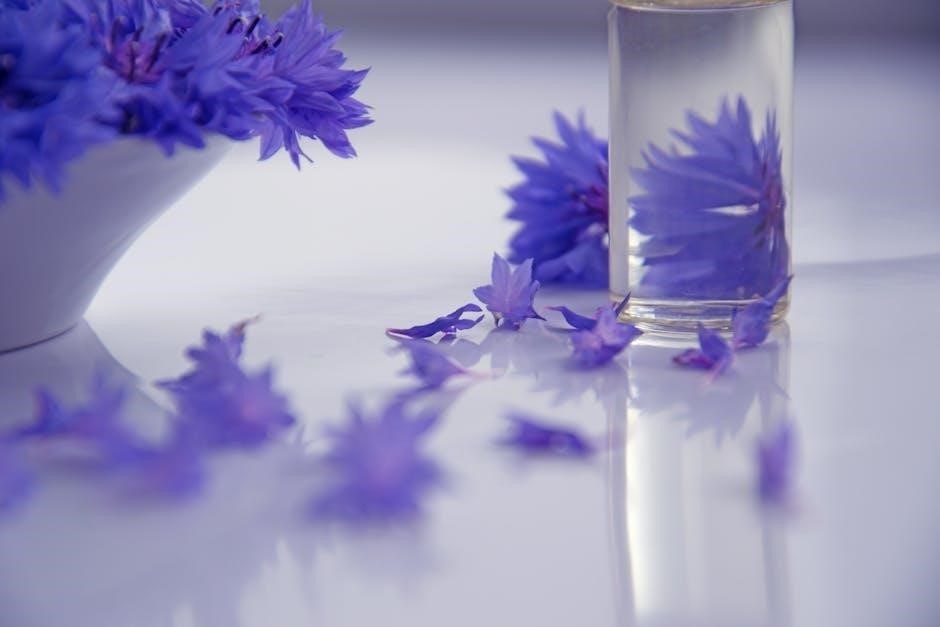
Troubleshooting Common Issues in Perfume Making
Address common challenges like separation, ricing, or hardness by adjusting dilution ratios, ensuring proper blending, and using high-quality ingredients for optimal fragrance stability.
How to Fix Separation or Hardening in Perfume Recipes
Separation or hardening in perfumes often occurs due to improper dilution ratios or ingredient incompatibility. To fix this, adjust the ratio of essential oils to carrier oils, ensuring a balanced blend. If the mixture hardens, gently heat it in a double boiler until softened. For separation, shake the blend thoroughly or add a small amount of alcohol to dissolve and unify the ingredients. Always test the consistency before bottling to ensure a smooth, even texture.

Adjusting Fragrance Strength and Longevity

Adjusting fragrance strength and longevity involves balancing essential oil concentrations and selecting appropriate notes. Increase essential oil percentage for strength, and add base notes like sandalwood for longevity. Use natural fixatives such as orris root to stabilize scents. Start with standard dilution ratios and adjust based on olfactory testing. Choose oils known for longevity and test the blend over time. Keep a journal to track changes and ensure safety with patch tests. Trial and error are key to achieving the desired fragrance profile.
With this guide, you’ve unlocked the basics of creating designer perfumes using essential oils. Embrace the creative journey, experiment with unique blends, and explore the endless possibilities of natural fragrances.
The Art of Perfumery: Encouraging Creativity and Experimentation
Perfumery is a blend of science and art, inviting you to explore endless possibilities with essential oils. Encourage creativity by experimenting with unique fragrance combinations, balancing top, middle, and base notes. Trust your instincts, as each blend is a personal expression. Start with simple recipes, then venture into complex scents. Remember, practice makes perfect, so don’t hesitate to try new oils and techniques. The world of perfumery is vast, and your creativity is the key to unlocking its secrets;
Resources for Learning More About Essential Oil Perfumes
Expand your knowledge with comprehensive guides and tutorials on essential oil perfumery. Explore online courses, eBooks, and workshops that detail blending techniques and safety tips. Engage with communities of perfumers to gain insights and share recipes. Visit trusted aromatherapy websites for detailed information on essential oil properties and safe usage. Manuals like the ‘Designer Perfume Recipes Using Essential Oils PDF’ provide practical recipes and expert advice, helping you refine your craft and create professional-quality fragrances at home.